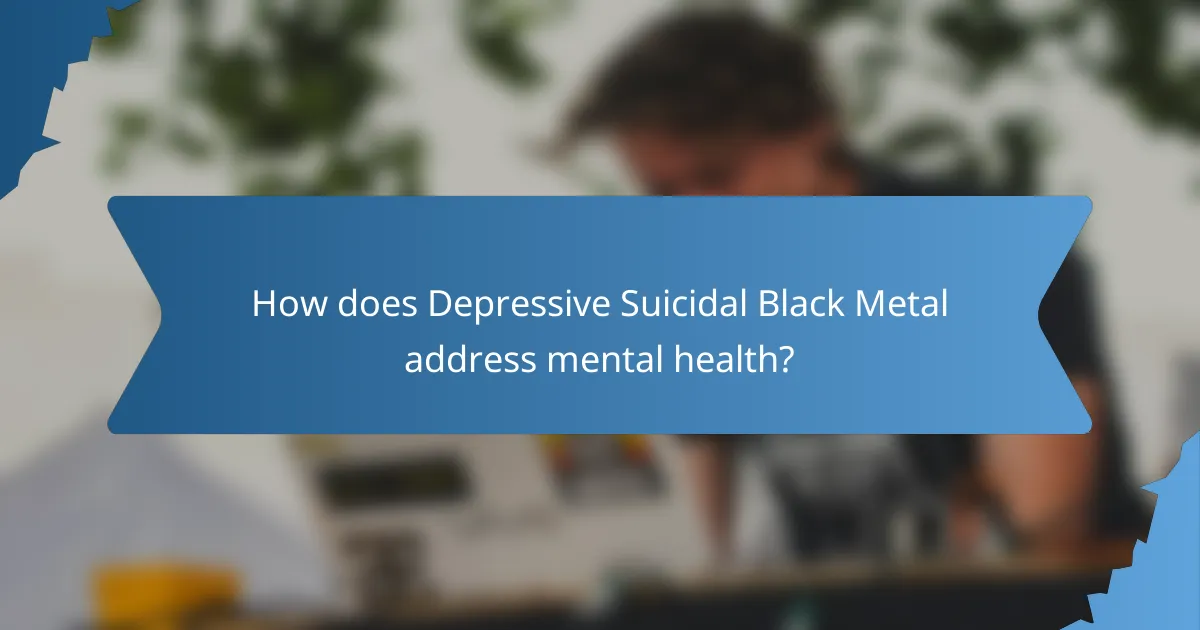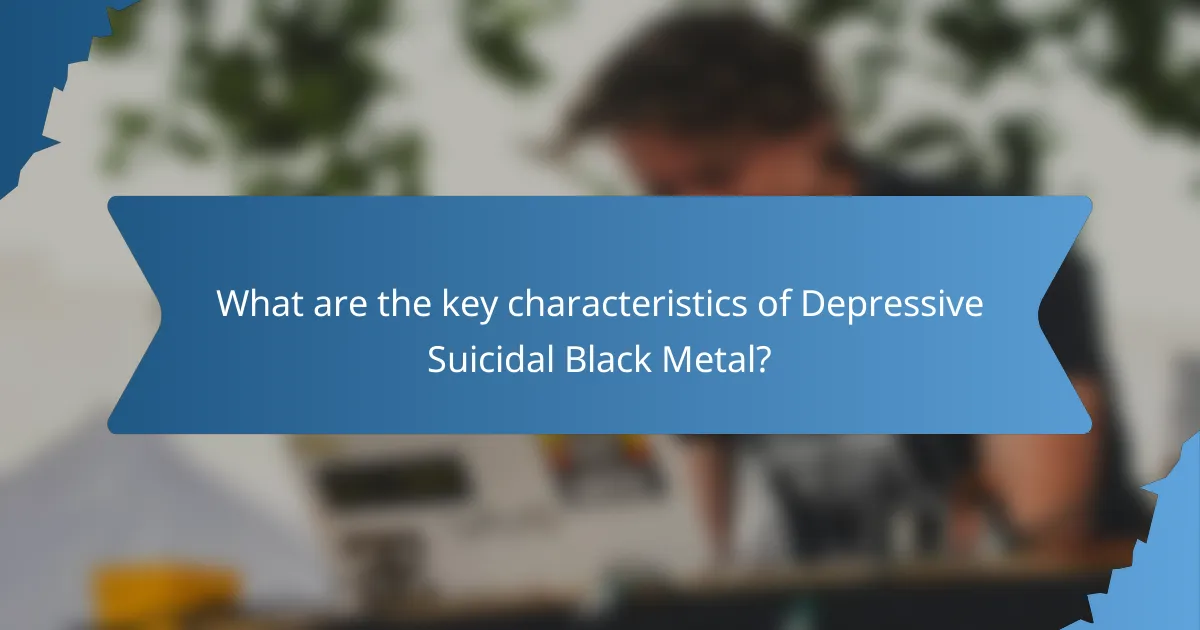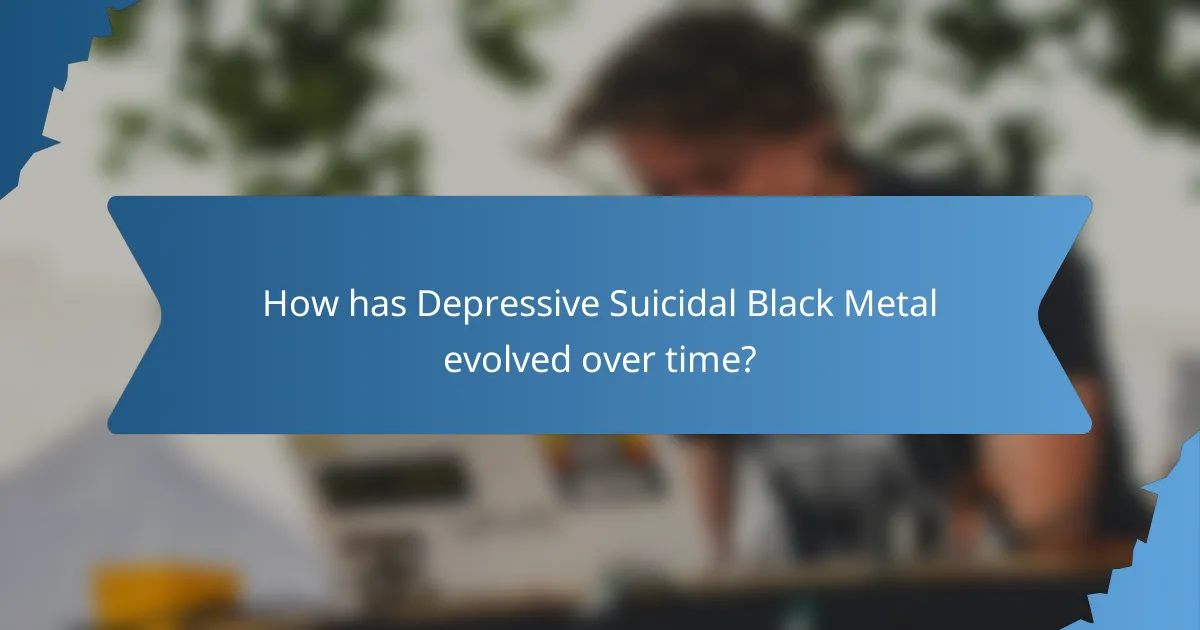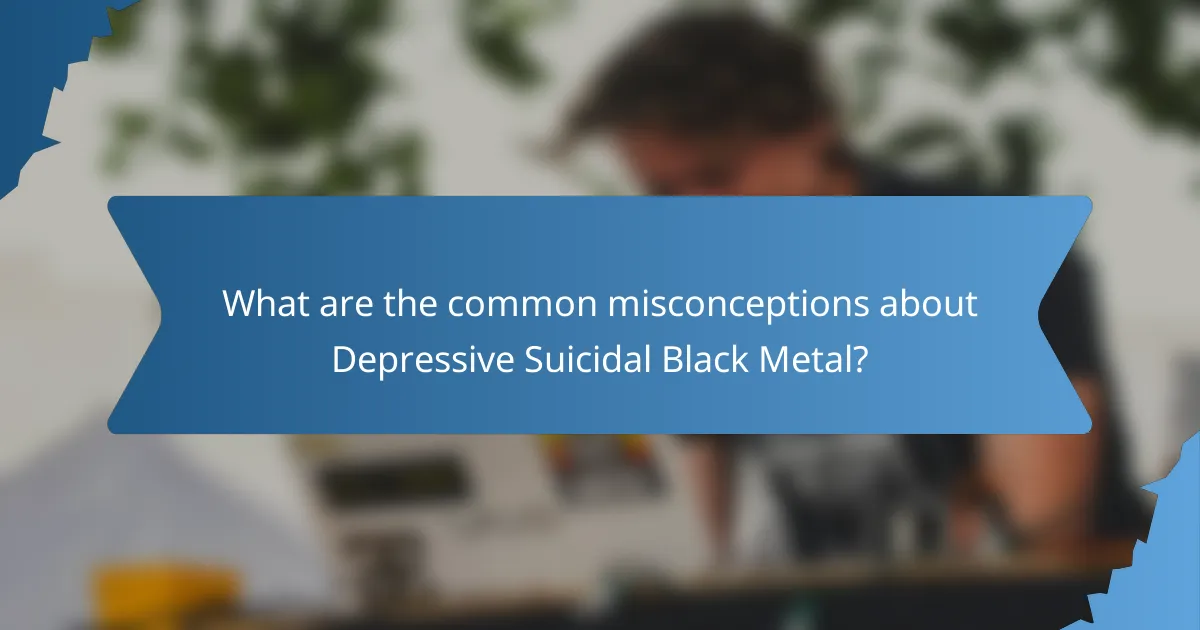Depressive Suicidal Black Metal (DSBM) delves into the depths of despair, isolation, and emotional anguish, offering a haunting reflection on mental health struggles. With its minimalistic musical style and raw emotional intensity, this genre serves as a powerful outlet for listeners grappling with feelings of depression and suicidal ideation. Through stark soundscapes and poignant lyrics, DSBM creates a space for profound emotional exploration and connection.

How does Depressive Suicidal Black Metal address mental health?
Depressive Suicidal Black Metal (DSBM) addresses mental health by exploring themes of despair, isolation, and emotional turmoil. Through its raw sound and lyrical content, this genre provides an outlet for listeners to confront and process their feelings of depression and suicidal ideation.
Emotional catharsis through music
DSBM offers a unique form of emotional catharsis, allowing listeners to release pent-up feelings through its intense soundscapes. The slow tempos and haunting melodies create a space where individuals can immerse themselves in their emotions, often leading to a sense of relief or understanding.
For many, engaging with this music can be a therapeutic experience, as it mirrors their struggles and validates their feelings. This connection can help individuals feel less alone in their battles with mental health.
Community support and connection
The DSBM community fosters a sense of belonging among individuals who share similar experiences with mental health issues. Online forums, social media groups, and live shows often serve as platforms for fans to connect, share stories, and support one another.
Participating in this community can be beneficial, as it encourages open discussions about mental health and reduces stigma. Many find solace in knowing that others understand their pain, which can be a crucial step toward healing.
Therapeutic themes in lyrics
The lyrics in DSBM often delve into themes of despair, loss, and existential dread, providing a stark reflection of the human condition. These themes resonate deeply with listeners, allowing them to confront their own struggles in a safe and artistic manner.
By articulating feelings that many may find difficult to express, DSBM lyrics can serve as a powerful tool for self-reflection and understanding. This can lead to a greater awareness of one’s mental health and the importance of seeking help when needed.

What are the key characteristics of Depressive Suicidal Black Metal?
Depressive Suicidal Black Metal (DSBM) is characterized by its raw emotional intensity, minimalistic musical style, and dark thematic content. This subgenre conveys deep feelings of despair and hopelessness, often using simple yet effective musical structures to enhance its emotional impact.
Raw emotional expression
Raw emotional expression is central to DSBM, where artists convey feelings of sadness, isolation, and existential dread. The vocal delivery often includes anguished screams or mournful whispers, creating a visceral connection with listeners. Lyrics typically reflect personal struggles, mental health issues, and a sense of overwhelming despair.
Many DSBM bands prioritize authenticity over technical proficiency, allowing the emotional weight of the music to resonate deeply. This approach can evoke a cathartic experience for both the artist and the audience, fostering a sense of shared suffering.
Minimalistic musical approach
The minimalistic musical approach in DSBM emphasizes simplicity and repetition, often featuring slow tempos and sparse instrumentation. Guitars may use tremolo picking and dissonant chords, while drums are typically subdued, creating an atmospheric backdrop that enhances the emotional tone. This simplicity allows the listener to focus on the feelings conveyed rather than complex musical arrangements.
Commonly, songs may stretch beyond the typical length, allowing for extended moments of reflection and immersion in the music. This approach can lead to a hypnotic effect, drawing listeners into the depths of the emotional landscape being portrayed.
Dark thematic content
Dark thematic content is a hallmark of DSBM, often exploring topics such as depression, suicide, and existential nihilism. Lyrics frequently delve into personal narratives of suffering, loss, and the struggle against inner demons. This thematic focus can be unsettling but serves to create a powerful emotional resonance with those who relate to these experiences.
While the themes may be heavy, they also provide a form of solace for listeners who find comfort in knowing they are not alone in their feelings. The stark portrayal of these themes often encourages discussions around mental health, making DSBM not just a musical genre but a platform for deeper conversations about emotional struggles.

Which bands exemplify Depressive Suicidal Black Metal?
Depressive Suicidal Black Metal (DSBM) is characterized by its bleak themes, raw emotional expression, and often minimalistic musical approach. Key bands in this genre have shaped its sound and ethos, each contributing unique elements that resonate with listeners seeking profound emotional depth.
Shining
Shining, hailing from Sweden, is a pioneering force in the DSBM scene, known for their intense and haunting soundscapes. Their music often combines elements of jazz and black metal, creating a unique atmosphere that reflects despair and existential angst.
Their albums, such as “V Halmstad” and “Klagopsalmer,” showcase a blend of melodic riffs and anguished vocals, effectively conveying the themes of mental turmoil. Shining’s approach emphasizes personal struggle, making their work relatable to those grappling with similar feelings.
Silencer
Silencer, a one-album project from Sweden, is notorious for its raw and unfiltered expression of pain and hopelessness. Their sole release, “Death – Pierce Me,” features a lo-fi production that enhances the emotional weight of the music, making it feel intimate and immediate.
The band’s use of dissonant guitar work and anguished screams creates a sound that is both unsettling and captivating. Silencer’s music is often described as a sonic representation of despair, appealing to listeners who appreciate extreme emotional honesty in their art.
Xasthur
Xasthur, the brainchild of Scott Conner from the United States, embodies the essence of DSBM through its atmospheric and haunting compositions. Known for their dark, ambient sound, Xasthur’s music often explores themes of isolation and despair, resonating deeply with fans of the genre.
Albums like “Nocturnal Poisoning” and “Telepathic with the Deceased” showcase a blend of black metal and ambient elements, creating a soundscape that is both eerie and reflective. Xasthur’s work is marked by its introspective lyrics and a strong sense of melancholy, making it a staple for those drawn to the darker aspects of human emotion.

How has Depressive Suicidal Black Metal evolved over time?
Depressive Suicidal Black Metal (DSBM) has evolved significantly since its inception, characterized by its deep emotional expression and minimalistic sound. Initially rooted in traditional black metal, it has branched into various subgenres and gained traction through digital platforms, shaping its accessibility and audience.
Influence of early black metal
The origins of DSBM can be traced back to the early black metal scene, which emphasized raw emotion and dark themes. Bands like Burzum and Xasthur laid the groundwork by incorporating melancholic melodies and introspective lyrics, setting the tone for future developments in the genre.
These early influences established a framework where personal suffering and despair became central themes, allowing DSBM to resonate with listeners seeking catharsis through music. The lo-fi production style also became a hallmark, enhancing the emotional weight of the sound.
Emergence of new subgenres
As DSBM gained popularity, various subgenres emerged, each adding unique elements while maintaining the core themes of depression and despair. For instance, some bands began to incorporate elements of post-rock, creating a more atmospheric sound that contrasts with traditional black metal’s aggression.
Other subgenres, such as suicidal black metal, focus even more intensely on themes of hopelessness and self-destruction, often resulting in a more extreme listening experience. This diversification has allowed DSBM to appeal to a broader audience while still retaining its distinct emotional core.
Impact of digital platforms
The rise of digital platforms has significantly influenced the evolution of DSBM, enabling artists to reach global audiences without the need for traditional record labels. Platforms like Bandcamp and SoundCloud have become essential for independent musicians to share their work and connect with fans.
This accessibility has led to an explosion of new DSBM bands, fostering a vibrant community where artists can experiment with their sound and themes. Additionally, social media allows for the sharing of personal stories and experiences, further deepening the genre’s emotional impact and connection with listeners.

What are the cultural implications of this genre in Australia?
Depressive suicidal black metal in Australia reflects deep societal issues, particularly around mental health and emotional expression. The genre’s raw themes resonate with listeners, fostering a sense of community among those grappling with similar struggles.
Representation of mental health issues
This genre often addresses mental health topics, providing a voice for those experiencing depression and suicidal thoughts. By confronting these themes, artists help destigmatize mental illness and encourage open discussions within Australian society.
Many bands incorporate personal narratives into their lyrics, allowing listeners to connect on an emotional level. This representation can be therapeutic, offering solace to fans who feel isolated in their struggles.
Local underground scene growth
The emergence of depressive suicidal black metal has contributed to the growth of Australia’s underground music scene. Small venues and DIY spaces have become hubs for local bands, fostering a supportive environment for artists and fans alike.
As more bands gain recognition, collaborations and events are becoming more common, further strengthening community ties. This grassroots movement is vital for nurturing new talent and keeping the genre alive.
Influence on Australian music festivals
Depressive suicidal black metal is gradually making its mark on music festivals across Australia. While traditionally dominated by mainstream genres, some festivals are now featuring black metal acts, reflecting a growing acceptance of diverse musical expressions.
These performances not only showcase the genre but also raise awareness about mental health issues among festival-goers. By including this genre, festivals can create a more inclusive atmosphere that resonates with a wider audience.

What are the common misconceptions about Depressive Suicidal Black Metal?
Many misconceptions surround Depressive Suicidal Black Metal (DSBM), often reducing it to mere shock value or glorification of self-harm. In reality, this genre delves into profound emotional struggles, using raw expression to convey feelings of despair and isolation.
It glorifies suicide and self-harm
A prevalent misconception is that DSBM glorifies suicide and self-harm. Instead, the genre often serves as a cathartic outlet for artists and listeners alike, providing a space to confront and process deep emotional pain. The lyrics and music reflect personal battles rather than promoting harmful actions.
It lacks musical complexity
Another common belief is that DSBM is musically simplistic. While the sound may be minimalistic, this approach enhances the emotional weight of the music. The raw production and repetitive structures are intentional, allowing listeners to immerse themselves in the atmosphere of despair.
It is not a legitimate form of art
Some critics dismiss DSBM as unworthy of recognition as an art form. However, the genre’s ability to articulate complex emotions and experiences demonstrates its artistic value. Many DSBM musicians are skilled in their craft, using music as a powerful medium for expression.
It appeals only to a niche audience
While DSBM may seem to cater to a specific audience, its themes resonate with a broader range of listeners who experience similar feelings of sadness and isolation. The genre’s authenticity can attract those seeking solace in shared emotional experiences, transcending typical genre boundaries.
